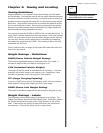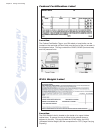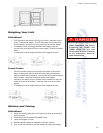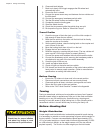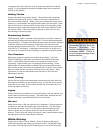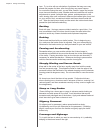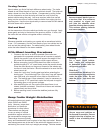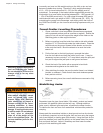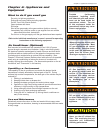
17
Chapter 3: Towing and Leveling
Turning Corners
Here is where you nd a rst basic difference when towing. The trailer
wheels do not follow the path of your tow vehicle’s wheels. The trailer will
make a closer turn than the tow vehicle. Compensate by pulling further
into the intersection so that the trailer will clear the curb or clear any
parked vehicles along the road. Left turns require a wider than normal
swing into the new lane of trafc to keep the trailer from edging into the
opposing lane. Use the turn signals early to communicate to trafc behind
and slow down well in advance.
Mud and Sand
Let the momentum of the tow vehicle and trailer carry you through. Apply
power gently and stay in the tracks of the previous vehicle. If stuck, tow
the trailer and tow vehicle out together without unhitching.
Parking
Whenever possible avoid parking on a grade with a recreational vehicle
in tow. If it is necessary, turn the front wheels of your tow vehicle into the
curb and set the parking brake. For added safety, place wheel chocks
under the trailer wheels on the down roadside.
Fifth-Wheel Leveling Procedures
1. Choose a site that is as level as possible (Some sites are
equipped with a prepared surface such as concrete or asphalt).
Ensure the ground is not soft and will support the weight of the
fth-wheel on the stabilizing jacks or other support devices.
2. Before uncoupling, level the fth-wheel from side to side with
suitable lengths of 2” x 6” wood blocks under the coach’s wheels.
Place the wood blocks on the ground forward of the wheels and
tow the unit onto the blocks. Block the wheels to be sure the fth-
wheel cannot roll.
3. Lower the “quick drop” landing gear legs before extending the
landing gear. The positioning of the “quick drop” legs will depend
upon how level your campsite is from side to side and front to
rear. The landing gear is then extended. It may be necessary to
place a sturdy 2” x 6” wood block under the foot pads to support
the landing gear on soft ground surfaces.
4. After stabilizing the unit, be sure the fth-wheel frame is not
twisted, buckled or stressed. Check that all doors and windows
operate freely and do not bind.
5. Before resuming travel, be sure the stabilizer jacks are fully
retracted.
Ramp Trailer Weight Distribution
All loaded trailers must remain
within GVWR and GAWR
limits. However, proper load
distribution is of particular
importance for ramp trailers.
These trailers are designed
to carry a variety of internal
combustion engine vehicles in
the transportation storage area.
These cargo items are typically
heavy and consideration must be given to how they are loaded. Because
most storage areas are at the rear of the vehicle the biggest concern is
maintaining the correct hitch or pin weight percentage. Vehicles loaded
Due to slower speeds, cars can
become trapped behind you on
a two-lane road. It is courteous
and practical to signal and
pull onto the shoulder when
possible allowing them to pass.
This reduces passing hazards
and saves tempers.
Note
Leveling
Put a small round bubble-
level inside the refrigerator
to determine proper level for
refrigerator operation.
Slide-Outs
In extended use situations, it is
advisable to add support blocks
under the slide- room. Do not
raise the room. Just touch the
bottom.
Note
Secure cargo and vehicles as
far forward as possible. Excess
weight in the rear of trailers can
result in loss of stability when
towing.



